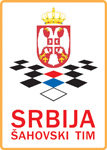 More than a Game More than a Game
EUROPEAN TEAM CHESS CHAMPIONSHIP HELD IN NOVI SAD, ONE OF THE EVENTS WHICH MARKED 2009 IN SPORTS
The Chess Wonderland
For the first time after nineteen years, after the Chess Olympics in Novi Sad in 1990, a competition of this level was held in Serbia. 66 national teams participated (male and female) from 38 European countries; there were 139 grandmasters among 350 competitors, and the championship website had almost a million visits, mainly to watch chess games live! The happiest were the Russian female and Azerbaijan male team, the countries of former USSR again demonstrated their absolute superiority, and the Serbian team clearly announced the beginning of a great revival
By: Josip Ašik
Photos: Serbian Chess Federation Archive
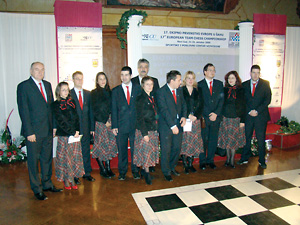 One would expect a chamber atmosphere at chess tournaments. It makes sense, this is the place where peace and quiet are very important. The players are deeply concentrated and the viewers tiptoe fearing they might make a sound, because then everyone would look at them reproachfully. It is not far from the truth, most of the time it is so at international competitions. The audience often watches games on screens in separate rooms and experts explain them what is happening in the game and why the player made such a move. One would expect a chamber atmosphere at chess tournaments. It makes sense, this is the place where peace and quiet are very important. The players are deeply concentrated and the viewers tiptoe fearing they might make a sound, because then everyone would look at them reproachfully. It is not far from the truth, most of the time it is so at international competitions. The audience often watches games on screens in separate rooms and experts explain them what is happening in the game and why the player made such a move.
However, when one comes to the land of Serbia, everything changes completely. Interpreters are not necessary here because here, in this land, there are more than 50 grandmasters and about 2.500 players in the international rating list. And they are only the top of the iceberg consisting of so many lovers of this ancient game. It is no accident that Serbia is statistically in the fourth place in the world by its number of highly ranked chess players, far beyond countries with a much bigger population such as Russia, USA and Germany.
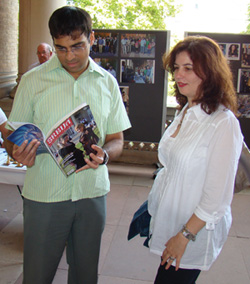 In Novi Sad, at the event which marked the last quarter of 2009 in sports, representatives of 38 European countries gathered. Many among them experienced a true ”chess cultural shock”. The audience squeezed around the tables, like in the pre-war times, and after completing the games numerous fans used the opportunity to, while asking for autographs, point to the chess players what they have done wrong and what they should play next time. For the whole 19 years, from the Chess Olympics in Novi Sad in 1990, such a big and important competition, such as the European Team Championship ”Novi Sad” (October 21-31) has not been held in Serbia. It has been a long time and lovers of this ancient game came to the SPENS arena as if coming to a pilgrimage, to see live the greatest world aces as well as those whom they can ”advise”. In Novi Sad, at the event which marked the last quarter of 2009 in sports, representatives of 38 European countries gathered. Many among them experienced a true ”chess cultural shock”. The audience squeezed around the tables, like in the pre-war times, and after completing the games numerous fans used the opportunity to, while asking for autographs, point to the chess players what they have done wrong and what they should play next time. For the whole 19 years, from the Chess Olympics in Novi Sad in 1990, such a big and important competition, such as the European Team Championship ”Novi Sad” (October 21-31) has not been held in Serbia. It has been a long time and lovers of this ancient game came to the SPENS arena as if coming to a pilgrimage, to see live the greatest world aces as well as those whom they can ”advise”.
Most interesting was naturally around tables where the Serbian national team played, whose members for the first time played in sports dresses with the national coat of arms and insignias. The audience was close, less than half a meter away. At one moment, the defensive fence broke down under the pressure and fell. Everyone wanted to see the games more closely. Regularity was unharmed – no one from aside played a move at the board! The selector Branko Damljanović did not allow the judges to move the fans further away.
– The audience is our fifth player! – joked our experienced chess player. – That is why we put the corpulent Miloš Perunović at the 4th board, to hold the fans on his back!
THE END OF A LONG DRY PERIOD
 Such interest of the big audience left a greatest impression on guests from abroad. Such interest of the big audience left a greatest impression on guests from abroad.
– Everyone here treats us as stars! – said the humble Greek chess player Dimitris Mastrovasilis. Praises also came from the Finnish team:
– Of course we are against moving the audience outside! We are happy so many people are interested in our playing! – said Tomi Lukonen.
Such support mostly contributed to the success of the Serbian national team with a new generation of chess players and new selector, previous champion Branko Damljanović and a new common visual image, created for raising the team spirit. Ivan Ivanišević is at the first board, but there are no big differences between the members of the team. The quality is equal, as well as their limitless enthusiasm and wish to present themselves at their best. As if in a dream, the Serbian team euphorically ended the competition. The eighth place among 38 teams is certainly not the same as a medal, but it’s a more than promising first big step.
 copy.jpg) Serbia is a chess nation with many trophies, but the times of great chess champions such as Gligorić and Ljubojević are far behind us. The last European medal, silver, was won by ladies, 10 years ago. Men have had a longer dry period – 20 years! However, Serbia started at the 17th average rating position at this competition, and its success is obvious. If you consider that Serbia won the actual Olympic champion Armenia on that road, the ovations to the Serbian team in that, perhaps historical, third round are understandable. Serbia is a chess nation with many trophies, but the times of great chess champions such as Gligorić and Ljubojević are far behind us. The last European medal, silver, was won by ladies, 10 years ago. Men have had a longer dry period – 20 years! However, Serbia started at the 17th average rating position at this competition, and its success is obvious. If you consider that Serbia won the actual Olympic champion Armenia on that road, the ovations to the Serbian team in that, perhaps historical, third round are understandable.
Round by round, news echo, Ivanišević wins Viktor Korchnoi, Robert Markuš wins the Armenian Pašikjan, Dragan Šolak resists Alexei Shirov, Bojan Vučković wins silver for individual results, Miloš Perunović is the ”golden” reserve. The final day of the competition, the Serbian Chess Team wins France considered a favorite. As if in a chess fairytale, legendary Svetozar Gligorić (86) and Ljubomir Ljubojević (59) stand by their boards.
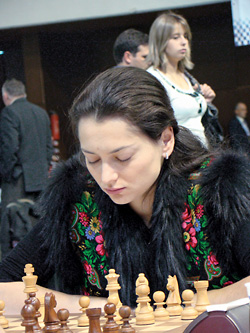 Serbia clearly indicated its chess renaissance and pointed the directions of further advancement, but some nations had every right to be even happier. Before all the winners. It is the grand finale. The final, ninth round. Russia is defending the title and is the first favorite. Its opponent is Spain, worthy of respect, but no more than this. Victory brings a new title, but it was not destined to be so. The brilliant Alexander Morozevich brought leading points, however the seventeen-year-old Salgado Lopez strikes back against the unfortunate Jakovenko. The total result – tied! Serbia clearly indicated its chess renaissance and pointed the directions of further advancement, but some nations had every right to be even happier. Before all the winners. It is the grand finale. The final, ninth round. Russia is defending the title and is the first favorite. Its opponent is Spain, worthy of respect, but no more than this. Victory brings a new title, but it was not destined to be so. The brilliant Alexander Morozevich brought leading points, however the seventeen-year-old Salgado Lopez strikes back against the unfortunate Jakovenko. The total result – tied!
It is Azerbaijan’s move. A sudden chance. Alas, already three games against the Netherlands were finished tied, and in the final one Gashimov plays against the invincible Stelwagen. Rook ending, tie at sight. The chess player from Baku waves his head, gets up, then returns to the board. He is looking for a way to push his opponent from the track. The drama is lasting too long; both Azerbaijanis and Russians are standing aside, each with their own hopes. Stelwagen breaks under extreme pressure. The crucial mistake within the reach of the port of salvation. Gashimov draws his moves in enchantment. The hand of surrender is in the air and all Azerbaijani chess players jump into each other’s arms exalted, while their national flag arrives from somewhere and covers them. The historical triumph of the young ex-Soviet republic and tremendous joy. They are the new European champions, for the first time ever.
HAND OF SURRENDER AND HAND OF VICTORY
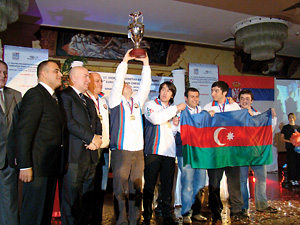 In the female competition, the Russians, defending their title, led the main battle with the ”land of female chess”, Georgia, which gave legendary world champions Nona Gapridashvili and Maja Chiburdanidze. The opponents entered the last round equal, but the Russian team, led by the actual world champion Alexandra Kosteniuk, was at their best. The victory over Armenia was just enough to maintain their dominance in European chess. Georgia kept the pace and shared first place, but additional criteria were not to its benefit. In the female competition, the Russians, defending their title, led the main battle with the ”land of female chess”, Georgia, which gave legendary world champions Nona Gapridashvili and Maja Chiburdanidze. The opponents entered the last round equal, but the Russian team, led by the actual world champion Alexandra Kosteniuk, was at their best. The victory over Armenia was just enough to maintain their dominance in European chess. Georgia kept the pace and shared first place, but additional criteria were not to its benefit.
The European Championship put into the foreground national teams with equal and harmonious members. One or two supreme aces are not enough. Chess is an individual discipline, but it is played on four boards. Bulgarians felt it best. They were in the fourth place, but finished the competition in the 18th! The world champion candidate Veselin Topalov at the first board simply did not have players in the mood. Some of the great names of world chess in Novi Sad included the Armenian Aronian, naturalized Spanish Alexei Shirov, Englishman Mickey Adams, Russians Svidler and Morozevich, Azerbaijanis Rajabov and Mamejarov, Italian Caruana and Frenchman Bacrot. Veterans were also there: Ukrainian Alexander Beliavsky playing for Slovenia and certainly the greatest name, ”Victor the Horrible”, legendary Victor Korchnoi, who, at the age of 79, easily led the successful Swiss team.
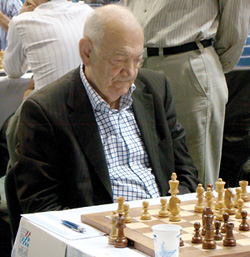 66 national teams participated at the European Championship in the male and female competition. Among 350 players, 139 of them had the highest chess title – grandmaster. 1.186 games were played, and only two of the originally planned did not take place, because the players were disqualified. First was the Bulgarian Delchev whose mobile phone rang, which is strictly forbidden, and the second was the Czech Laznichka who did not show up at the official start of the game because at the worst moment he went for a coffee. 66 national teams participated at the European Championship in the male and female competition. Among 350 players, 139 of them had the highest chess title – grandmaster. 1.186 games were played, and only two of the originally planned did not take place, because the players were disqualified. First was the Bulgarian Delchev whose mobile phone rang, which is strictly forbidden, and the second was the Czech Laznichka who did not show up at the official start of the game because at the worst moment he went for a coffee.
An important part of this success story is the fact that the official Championship website had about a million visits, mostly due to the live broadcasts of the games. The satisfaction with the achieved was universal, and especially happy for the successfully organized event were Vojislav Tabački, president of the Organization Board and Assistant to the Republic of Serbia Minister of Sports, and Milutin Karaklajić, president of the Serbian Chess Association and creator of our national team revival. The next European Championship will be held in two years, and the first next big exam for the Serbian team is the Chess Olympics played in 2010 in Siberia.
***
Stage
Men: gold Azerbaijan, silver Russia, bronze Ukraine.
Women: gold Russia, silver Georgia, bronze Ukraine.
***
Most Successful Individuals
Golden medals for individual achievements were won by Russian Nadezhda Kozinceva with 8 points in 9 games, and Ukranian Pavel Eljanov with 6 points in 8 games. The Serbian team member, mathematician from Belgrade, grandmaster Bojan Vučković won a silver medal for his achievements on the 3rd board.
***
Invitations
Besides the great improvement of results, the common visual identity – noble or sports depending on the occasion – also contributed to the big interest in the Serbian team. Several countries from the European federation also showed great interest and suggested different forms of cooperation. Furthermore, invitations for friendly matches came from Italy, Greece, Turkey and Slovenia. Serbia was also invited to participate in the regional competition of Central European countries, the traditional ”Mitropa Cup”.
***
World Champion Reads National Review
A true definition of the respect the Serbs have for chess and chess players was given by the actual world champion, Indian Vishvanatan Anand, in an interview in Baden Baden at the end of last summer. While going through Serbia – National Review in the company of the best Serbian chess player Alisa Marić, Anand remembered his tournaments in Belgrade more than a decade ago.
– I knew if I was playing well or not based on the mumbling of the audience of Sava Centar – said the ”chess tiger from Madras”. – They are chess lovers who know chess so well that they notice even the tiniest and finest shades. It was an honor to play before such an audience!
***
Applause
When Anand’s predecessor at the world chess throne Vladimir Kramnik defended his title in the match against Veselin Topalov in 2007 in Elista, he was asked if that was the first applause he received on an open stage.
– No, it is not – replied Kramnik. – In Belgrade, after an important victory, I had several minutes of ovations of two thousand viewers in a full room! Nothing can compare to that!
|
